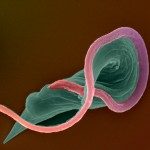Lien vers Pubmed [PMID] – 19459229
Mol. Biochem. Parasitol. 2009 Aug;166(2):194-7
Genetic manipulation in African trypanosomes typically relies upon electroporation with chromosomal integration of DNA constructs by homologous recombination. Relatively little is known about chromosomal recombination and repair in these organisms however and low transformation efficiency and position effects can limit forward genetic approaches. In yeast and mammalian cells, site-specific DNA double-strand breaks (DSBs) stimulate targeted integration through homologous recombination-based repair where the exogenous DNA serves as the template. We have explored the effect of DSBs on targeted integration in bloodstream-form Trypanosoma brucei, focusing on the ribosomal RNA-spacer target commonly used to integrate recombinant constructs. DSB-repair within the ribosomal RNA tandem gene-repeats is likely dominated by single-strand annealing allowing approximately 80% of cells to survive the break. In the presence of exogenous DNA, transformation efficiency is increased approximately 250-fold by DSB-induction. In the example presented, more than 1% of cells that survive the procedure were transformed generating 80,000 transformants from a typical experiment.

